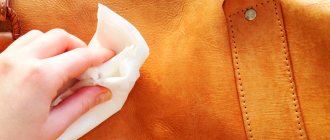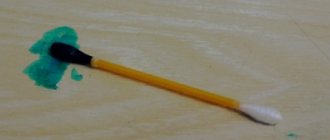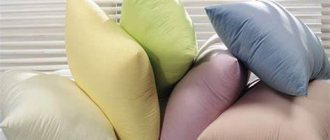Leather will always be in demand. Products made from this material are durable and can last up to 10 years. If the care of the leather belt was correct and the owner did not neglect cleaning and impregnation, then it will not become dull.
However, for many people the product lies idle for many years (some people keep a belt for a specific occasion, while others have several of them and use only one, and the second as a reserve), as a result the skin becomes rough and inflexible.
You can use home remedies to soften the natural material. They will help restore skin elasticity, flexibility and attractiveness.
Castor oil
This method is one of the best. Castor oil does not deform the product, but, on the contrary, will return it to its former flexibility and attractiveness.
You will need a lot of castor oil. Buy 10 bottles of the product, it’s better to have some leftover than to often run to the pharmacy.
Prepare an unnecessary rag or towel. Castor oil is greasy and sometimes you will have to dry your hands.
How to soften leather belts:
- Take the product, unscrew the cap and pour it into another container. You can apply the oil with a pipette, a cloth, or immediately pour large drops from the bottle along the entire length of the belt.
- Use your hands or a sponge to rub the product over the entire surface. Process gradually inside and out, try not to miss a single area.
- The belt will begin to darken, this is normal. Leave the belt to soak in the product for a while.
- When the castor oil is completely absorbed, the procedure is repeated. And so on until the product stops being absorbed.
Castor oil is the most ideal and suitable option for softening the skin. This method is suitable for belts made of dark material.
Light-colored belts cannot be treated with castor oil. The skin will darken.
How to soften the leather on a bag or belt: folk methods
If things are updated more often, then accessories can be worn for decades, combining them with basic clothing. In this section we will talk about how to properly store these wardrobe items, as well as easy care.
Belts. Despite the fact that in most films and media publications belts are stored on shelves, in drawers, etc., the best place for storage is in an unfolded position (hanging on hangers, hooks).
One of the options for softening the leather on a belt is with Vaseline
If the belt has become rough, dry and not very elastic, warm it slightly with a regular hair dryer (the skin pores will open) and apply regular Vaseline in a thick layer. Leave in the “soaked” state for 30 minutes, then rub the Vaseline with a lint-free cloth until completely absorbed. Leave the belt in a flat, horizontal position in a place out of direct sunlight for a day.
Leather bag . Such bags must be cleaned with soapy water every six months and then wiped with a damp cloth. After drying, apply linseed, olive, castor or coconut oil, or a mixture of them. It is thoroughly rubbed into the skin and the bag is not taken outside for 24 hours (exposed to dust, sunlight, etc.).
If the bag is not currently being worn, it is recommended to store it in a breathable fabric cover to protect it from dust and accidental stains.
Clean and soften suede
Suede bag . Suede bags are elegance and style, but their downside is the quick loss of their original appearance.
In order to clean and soften the skin you will need:
- We clean the suede from visible dust and dirt with a dry soft brush;
- We hold the suede over the steam, but so that not even a drop of boiling water gets on it so that the suede opens the pores;
- Let it dry and repeat up to five cycles if necessary;
- If after this the suede has not acquired its original appearance, we proceed to the sixth stage - chemical cleaning. Pour a teaspoon of vinegar into a liter of water and stir thoroughly;
- Wipe the suede until it is damp and let it dry.
We hope that our article has revealed the secrets of caring for leather and suede products and you can now easily care for your clothes and accessories at minimal expense. And in conclusion, we will add a video review on how to soften different types of leather.
Petrolatum
If you need to tidy up a light-colored item, buy Vaseline. It costs a penny, but is effective.
How to make a belt soft:
- Take a small amount of Vaseline and apply a small area of the waistband. If all is well, continue applying the ointment over the entire surface.
- To restore leather jackets, you can use 2 squirrels, lemon and Vaseline. First, the material is treated with whipped egg white, after 4 hours it is necessary to remove the residue and wipe the surface with a damp sponge. Then treat with a slice of lemon or orange and leave for 2 hours. Afterwards, remove the residue again with a damp cloth and treat with Vaseline. This method can also be used for belts.
Vaseline can soften a leather belt, but its effect does not last long. To bring the item back to life, you need to treat it with ointment every week for 1–2 months.
Use of glycerin
For skin softening, glycerin is a controversial product. There is debate about the possibility of its use. Some do not recommend using it at all, as do factory softeners based on it (as well as products with paraffin or silicone). But glycerin can be used as one of the elements.
It is applied like this:
- First, the surface is treated with whipped egg white.
- Then (after cleaning) wipe with lemon.
- After drying, glycerin is applied to the surface.
- After 12 hours, the product must be washed.
Leather items can also deteriorate if stored improperly or not used for a long period of time. In order not to think about how to soften a leather belt later, you need to take care in time to preserve its properties. Before storing the belt in a drawer for a long time, you can lubricate the inside of the product with vinegar.
Baby cream
To restore the elasticity of a leather belt, you can use baby cream. It's better to buy a moisturizer.
Baby cream is applied to the product in a thin layer and left to absorb for a while. Then the procedure is repeated.
It is not recommended to use creams for adults, since they contain substances that are harmful to leather products, but if they are made from natural ingredients, then nothing bad will happen.
Why does the leather on leather products harden: reasons
Leather is an organic material that loses its characteristics over the years if it is not properly cared for. Without proper care, leather products become coarser, become tougher, and later cracks appear and the leather can only be disposed of.
Professional products for softening and cleaning leather items and accessories
Five reasons why the skin becomes rough:
- Poor quality dressing of skins;
- Constant contact with moisture;
- Regular contact with sunlight;
- Frequent exposure to low temperatures;
- Contact with chemicals.
If you have purchased an expensive, high-quality leather item and want it to last for years, do not skimp on professional leather care products. This is a worthwhile investment and will pay off in full by keeping your skin soft and fresh for a long time.
Causes of belt sagging and twisting
Quite often a situation arises when, even after wearing the belt for a short time, its edge begins to “wiggle”, stretch and twist. This happens for a number of reasons:
- a change in technology, during which the skin is cut across the collagen fibers;
- using leather not from the “back” part of the skin, but from the sides or belly;
- a special technological process for welding collagen fibers, which reduces the cost of production;
- poor quality material.
In order to avoid such problems with the belt, you should choose products from a trusted manufacturer . Prices for such a belt will be in the “above average” category. But this will make it possible to use it for a long period of time without losing its appearance.
Affordable ways to soften a leather jacket at home
If you do not want to feel discomfort when putting on a new leather jacket, it is better not to wear it immediately after purchase, but to use one of the methods that will help soften the new material. The jacket will need time for the leather to break in and fit on you.
This is especially true for men's rough jackets, whose cuffs and collars are much harder at first.
In order not to waste time and not torment yourself with an uncomfortable thing, without altering your leather jacket, treat it at home, making the leather softer and more pliable. If you don’t know how to properly make leather softer, contact the Mobile Tailor studio.
Ways to soften shoes
Made from genuine leather
The supermarket sells many different products to soften hard skin. Well-known manufacturers produce creams and sprays for shoe care.
Before treatment, apply a spray to the damaged area. Then it is lubricated with cream. Factory products can be replaced with alcohol, but softening will take much longer.
To soften natural rough skin, do not treat it with sunflower oil. This will make her even tougher.
Shoes made of genuine leather lend themselves well to softening. You can use methods such as rubbing with Vaseline, vinegar solution, and kerosene.
You can try this method: cover the hard part of the shoe with a thick cloth and then tap with a hammer on the area that needs to be softened. Put on shoes and walk around in them; if the effect is not good enough, then repeat the procedure, but the main thing is not to overdo it.
PU Leather
The best way to soften such skin is to create a greenhouse for it. To do this, you need to moisten a cloth with water and wrap it around the box of shoes. Wait until the rag is completely dry.
You can use newspapers to soften:
- wet the crumpled newspaper;
- stuff your shoes tightly with it;
- leave for a while so that the newspaper dries well.
Heel counter
Sometimes shoes fit perfectly on the foot, but a hard heel prevents you from walking normally. The most common methods to soften it:
- Take a hammer and tap the shoe in and around the heel area. Carry out the procedure carefully so as not to damage the shoes. If the skin color is light or it is thin, then you need to tap through a dense material.
- Moisten the backs with vinegar. It will soften them well, but not everyone can tolerate its pungent smell.
- Purchase special softening products. However, this method will not save money.
- You can apply sunflower oil to the heel and leave it overnight if the shoes are made of artificial materials. During this time it should become softer.
- Sew or carefully glue a soft cloth to the back. It will protect the heel from friction with hard skin.
- Shoe departments sell special pads. They are glued on the inside to protect the heel from rubbing. But there is a drawback: with active walking, the pad can move out.
- Use special pencils. They will make the inside slippery, which will reduce friction.
- If none of the methods helped in the fight against a hard heel, then you should contact a workshop, perhaps they will find another solution.
Softening the skin inside
To soften the leather inside the shoe, you can use these tips.
- Moisten the inside of the shoes with alcohol, put them on and walk in them for about 2 hours. This will help soften stiff areas and also stretch small shoes.
- Rub the inside of the shoe with paraffin (a regular candle) and leave overnight. In the morning, remove excess product. The method will get rid of calluses.
- Stuff each shoe or shoe with wet newspapers. Allow to dry, but away from heating appliances.
- You can also try this unusual method. Pour water into the bags (¼ part), put them inside the shoes (boots), put the shoes in the freezer, let the water freeze, then take out the shoes and try them on.
Lifesaver - egg white
If you don’t have any of the above remedies at home, and you need to restore the jacket as quickly as possible, you can use egg white. To do this, carefully separate the yolk from the white so as not to spoil the item with the composition and not to take your leather jacket for repair. Beat the egg whites until they form a stable foam; it is most convenient to do this with a mixer.
Soak a rag in the resulting mixture and apply it to the jacket.
Note! When choosing a place for this procedure, keep in mind that protein may drip onto the floor during and after rubbing.
After the entire surface of the jacket has been treated, leave it for 4 hours. After the time has passed, wipe off any unabsorbed protein and leave the jacket to dry.
Features of wearing faux leather shoes
To ensure that the procedures carried out do not damage leatherette shoes, the peculiarities of their stretching should be taken into account.
- After using various products, you need to apply a special cream that will lubricate the surface.
- Cooling or heating is not suitable for items made of varnished or thin materials.
- If the shoe fits true to size, but its heel rubs your foot, there is no need to stretch the product completely. Simply rub the backdrop with dry laundry soap or a paraffin candle.
What explains the increased hardness of the skin?
The leather of various animals is used for tanning: pigs, bulls, cows, calves, crocodiles, snakes and other representatives of fauna. Each animal has its own characteristics of the skin, including hardness. For example, bovine leather is thicker than cow leather, so jackets made from it are much denser and harder. Clothes made from calfskin are quite delicate, but become tougher as the animal ages.
In addition, hardness depends on the processing method. At the tanning stage, the raw material loses its moisture capacity, which makes it impossible to swell upon contact with water, and the mobility of collagen macromolecules is also limited - due to this, strength and wear resistance increase.
The leather is treated with various substances, which allows it to be given the necessary characteristics. For example, chrome tanning makes it elastic and soft, while vegetable tanning increases its hardness. This leather was used to make armor and book bindings.
How to avoid hardening of the jacket?
Remember that the best way to avoid repairs to outerwear is proper and timely care. Follow the following rules, and you will not have to alter your jacket or contact specialized workshops:
- Avoid drying out your skin. Store your jacket in a closed, dark closet rather than on an open hanger.
- When storing your jacket in the closet for a long time, use a fabric cover instead of a plastic one. They can be purchased at any hardware store.
- The best storage option is constant wear. The leather may become rough and cracked while you are not wearing the item. If you leave the product hanging in the closet for a long time, be prepared to spend money on repairing it with liquid leather.
Recommendations for choosing softening agents
They choose cosmetics, focusing primarily on the type of leather:
| With a smooth front surface | For such things, there is a large selection of universal creams, waxes, impregnations, emulsions, sprays of various consistencies and purposes. They are a combination of ingredients that matt or make surfaces shiny, protect, and restore minor damage. |
| With pile | Velor, suede, nubuck with a less dense structure than smooth types need to be refreshed and softened with specially designed caring and cleansing compounds. Upon completion of all procedures, the pile must be carefully combed out with a special brush. |
| Varnish | Due to the presence of a coating of several layers of polymer, conventional products are not suitable in this case, as they leave marks on the mirror-smooth surface, destroy it and make it duller. You need to choose quick-acting sprays, rub them thoroughly, removing any residue. |
| Painted | In this case, it is advisable to choose a care composition of the same color as the leather material, or colorless. Before use, try on an inconspicuous place to ensure good results. |
| Exotic animals | It is preferable to use special cosmetics for the material of a particular animal. When using universal cosmetics, you must carefully read the instructions so that there are no contraindications for exotic materials. |
Old thick skin can easily withstand the prolonged action of a saturated oil-fat composition. When processing thinner, more delicate materials and products, you should not apply softening cream for a long time or allow the material to get wet through. In any case, it is imperative that the care product matches your skin type and follows the manufacturer’s recommendations for use.
I myself use regular hand cream. Sometimes I take baby cream, it is more oily. Absorbs perfectly and softens wonderfully.
That's basically all. You can tell a lot, but this is briefly for general information and application. I hope this article will be useful.










